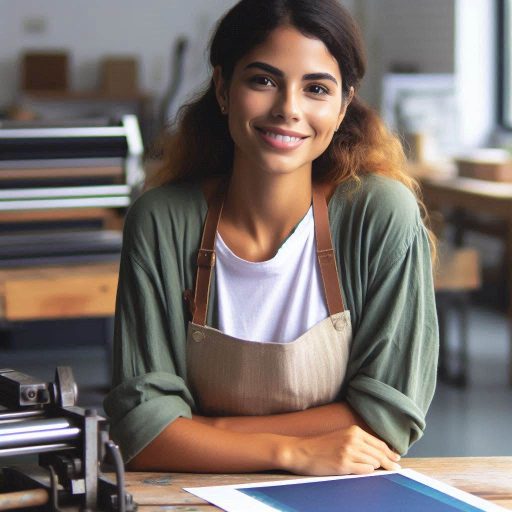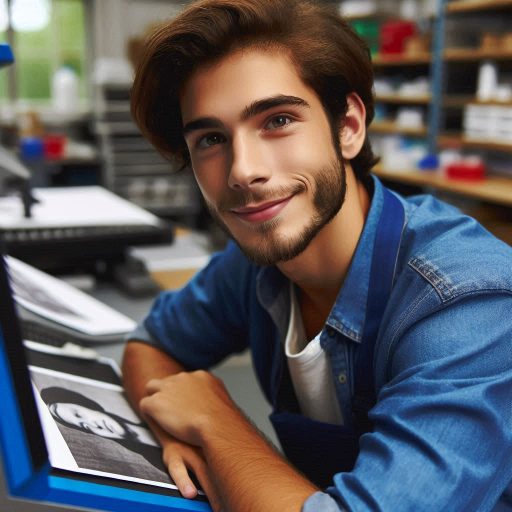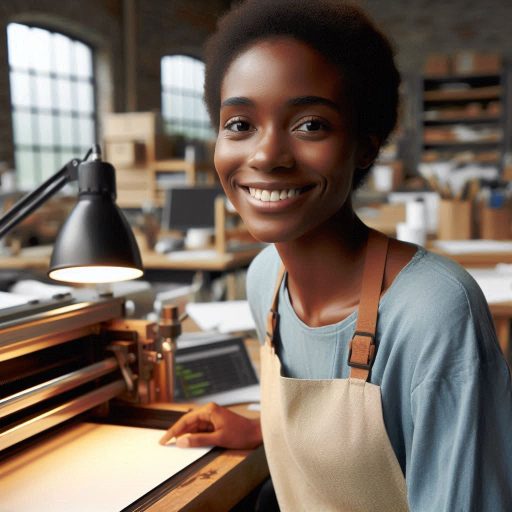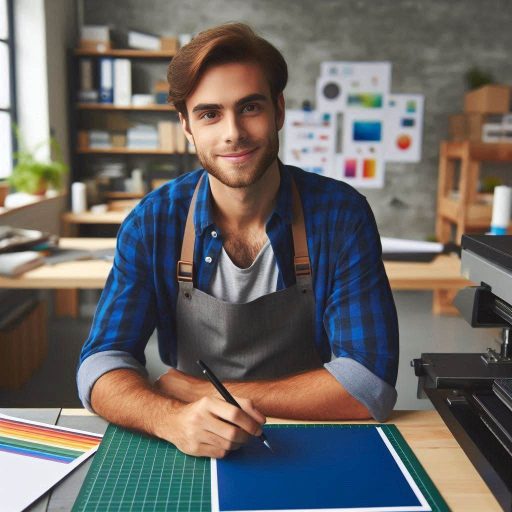Introduction
Printmaking is a diverse artistic practice that involves creating artworks by transferring images onto paper or other materials.
Exploring different printmaking techniques allows artists to bring their creative vision to life through unique processes.
In this blog post, we will delve into the world of collagraph printing, a versatile technique that offers endless possibilities for artistic expression.
Collagraph printing involves creating a printing plate by collaging different materials onto a base, such as cardboard or wood.
These materials can include textures, fabrics, papers, and even found objects, adding depth and intricacy to the final print.
Once the plate is completed, it is inked and pressed onto paper using a printing press, transferring the image onto the paper surface.
Many artists have embraced collagraph printing as a means of creating visually captivating and textured artworks.
One notable artist who utilizes this technique is Elena Gorelik, known for her intricate collagraph prints that explore themes of nature and mythology.
Another artist, Mark Lunning, creates stunning collagraph prints that incorporate vibrant colors and abstract forms to evoke a sense of movement and energy.
Collagraph printing offers a wealth of creative possibilities for artists to experiment with texture, color, and composition, making it a popular choice in the world of printmaking.
What is Collagraph Printing?
Collagraph printing is a unique printmaking technique that involves adding materials to a rigid substrate to create a textured surface for printing.
This process allows artists to experiment with different textures and shapes to produce one-of-a-kind prints.
Creating collagraph prints is a versatile and creative process that can be done using a variety of materials.
Some common materials include cardboard, fabrics, and found objects.
These materials are attached to the substrate to build up the desired texture for printing.
Creating a Collagraph Print
To create a collagraph print, artists start by selecting a rigid substrate such as cardboard or a wooden board.
This will serve as the base for building up the textured surface.
Next, materials like fabrics, papers, threads, or even textured items like leaves or string are added to the substrate.
These materials can be glued, taped, or adhered using various methods to create interesting patterns and textures.
Building Texture
Building texture on a collagraph plate is a crucial step in the printmaking process.
Transform Your Career Today
Unlock a personalized career strategy that drives real results. Get tailored advice and a roadmap designed just for you.
Start NowArtists can create different levels of texture by layering materials in different ways.
Some artists may choose to combine smooth surfaces with rough textures to add contrast and visual interest to their prints.
Experimenting with different materials and techniques can lead to unexpected and exciting results.
Inking the Collagraph Plate
Once the collagraph plate is prepared with the desired textures, it is time to ink the surface.
Artists can use various types of printmaking ink, such as oil-based or water-based inks, depending on their preference.
Inking a collagraph plate requires a careful and precise approach to ensure that the ink evenly covers the textured surface.
Artists can use brayers or brushes to apply the ink, making sure to work it into the nooks and crannies of the textured materials.
Printing the Collagraph
After the collagraph plate is fully inked, it is ready for printing.
Artists can use a printing press or hand-printing techniques to transfer the image onto paper or another printing surface.
When printing a collagraph plate, artists should experiment with different pressures and techniques to achieve the desired results.
Varying the pressure applied to the plate can result in prints with different levels of ink coverage and texture.
Finalizing the Print
Once the print is pulled from the collagraph plate, artists may choose to make additional adjustments or embellishments.
This could include hand-coloring the print, adding collage elements, or experimenting with different printing techniques.
Each collagraph print is a unique piece of art that reflects the artist’s creativity and experimentation with materials and textures.
The versatility of collagraph printing allows artists to create a wide range of effects, from subtle textures to bold, exaggerated patterns.
Collagraph printing is a versatile and creative printmaking technique that offers artists endless possibilities for experimentation.
By using a variety of materials and textures, artists can create unique and visually engaging prints that reflect their individual style and artistic vision.
So, next time you’re feeling inspired to create, consider trying your hand at collagraph printing and see where your creativity takes you.
Read: Tips for Maintaining Your Ceramic Art Studio
Materials Required for Collagraph Printing
The materials needed for collagraph printing, including a rigid substrate (such as cardboard), adhesives, inks, and a printing press or hand brayer
Transform Your Career Today
Unlock a personalized career strategy that drives real results. Get tailored advice and a roadmap designed just for you.
Start NowCollagraph printing is a versatile and creative printmaking technique.
To begin, gather the essential materials for a successful collagraph print.
First, select a rigid substrate like cardboard or acrylic for your printing plate.
This substrate needs to be sturdy enough to support the various textures you will add.
Cut the substrate to your desired size, ensuring it is flat and smooth.
The importance of choosing materials that will create interesting textures and effects in the final print
Next, choose suitable adhesives.
These adhesives will attach materials to your substrate, creating a textured surface.
Common adhesives include PVA glue and acrylic gel medium.
Apply these adhesives to secure your texture materials, such as fabric, sand, or string, onto the substrate.
For the printing process, you’ll need inks.
Use printmaking inks designed for collagraphy.
These inks are thick and viscous, which helps them retain details and textures from your plate.
You can find a variety of colors to experiment with and enhance your prints.
A printing press or a hand brayer is also essential.
A printing press applies even pressure across your plate, which helps transfer the ink to the paper.
If you don‘t have a press, a hand brayer can be used to roll ink onto your plate manually.
Ensure you have a clean, smooth surface to roll out your ink.
Choosing the right materials is crucial for creating interesting textures and effects in your final print.
Opt for materials that offer varied textures and contrasts.
The more diverse your textures, the more unique your print will be.
Transform Your Career Today
Unlock a personalized career strategy that drives real results. Get tailored advice and a roadmap designed just for you.
Start NowExperiment with different combinations to discover how they affect the final print.
By carefully selecting your materials and understanding their role, you can achieve rich, dynamic prints in collagraph printing.
Read: How to Frame and Preserve Printmaking Art
Creating a Collagraph Plate
The process of creating a collagraph plate, including cutting, layering, and gluing materials onto the substrate
Creating a collagraph plate involves a series of steps that transform a simple substrate into a textured masterpiece.
Start by selecting your substrate.
Common choices include cardboard, wood, or acrylic.
Ensure the substrate is clean and dry before beginning.
First, cut your substrate to the desired size.
Use a ruler and craft knife for precise measurements.
Smooth any rough edges to prevent issues during printing.
Next, layer materials onto the substrate.
Choose a variety of textures, such as fabric, string, or textured paper.
Arrange these materials to create interesting patterns and surfaces.
Experiment with different combinations to discover unique effects.
Once your materials are arranged, glue them onto the substrate using a strong adhesive.
Apply the glue evenly to ensure all pieces stick securely.
Allow the glue to dry completely before moving on to the next step.
Tips for artists on how to build up layers and textures to achieve desired effects in their prints
Building up layers is crucial for achieving depth and texture in collagraph prints.
Start with a base layer of materials, then add additional layers to enhance the texture.
Transform Your Career Today
Unlock a personalized career strategy that drives real results. Get tailored advice and a roadmap designed just for you.
Start NowUse materials with varying textures and thicknesses for a more dynamic plate.
Consider using embossing techniques to create raised areas on your plate.
Apply thin layers of glue or modeling paste, then let them dry before adding more materials.
This method can produce intricate textures and depth in your print.
For best results, experiment with different combinations of materials and layering techniques.
Test your plate by making trial prints to see how the textures transfer.
Adjust and refine your plate based on these test prints to achieve your desired effects.
Creating a collagraph plate is both an art and a science.
Through experimentation and careful crafting, you can produce stunning, textured prints that showcase your creativity and technical skill.
Read: Ceramic Art as a Therapeutic Practice

Inking and Printing Process in Collagraph Printing
Preparing Ink for Collagraph Printing
Start by choosing the right ink for collagraph printing.
Oil-based inks are commonly used for their flexibility and smooth application.
Begin by mixing the ink with a small amount of extender or medium to achieve the desired consistency.
Ensure the ink is well-blended to prevent inconsistencies in your prints.
Test the ink on a scrap piece of paper to check its thickness and flow.
Inking the Collagraph Plate
Clean the collagraph plate thoroughly before inking to remove any dust or debris.
Apply a thin, even layer of ink using a brayer or roller.
Work the ink into the grooves and textures of the plate, ensuring it reaches all areas.
Wipe away excess ink from the plate‘s surface with a clean cloth or paper.
This helps to highlight the textured areas while keeping the high points clean.
Transform Your Career Today
Unlock a personalized career strategy that drives real results. Get tailored advice and a roadmap designed just for you.
Start NowPrinting Process: Using a Printing Press
Place the inked collagraph plate on the press bed.
Carefully position your paper on top of the plate, aligning it precisely.
Adjust the pressure settings on the press to suit the thickness of the plate and paper.
Run the plate and paper through the press, applying even pressure to transfer the ink.
Check the print for even inking and make adjustments if necessary.
Printing Process: Hand Printing
For hand printing, place the inked plate on a flat, sturdy surface.
Lay your paper on top of the plate and press it down with a clean, flat tool, such as a baren or spoon.
Apply even, consistent pressure across the paper to ensure a clear transfer of ink.
Carefully lift the paper from the plate, revealing the print.
If necessary, repeat the inking and printing process to achieve desired results.
Achieving Consistent and High-Quality Prints
To ensure consistent results, maintain the same inking technique for each print.
Regularly check the plate and ink for wear and tear.
Adjust your printing method based on the paper‘s response and the plate‘s texture.
With practice and attention to detail, you‘ll produce high-quality collagraph prints that highlight the unique textures and details of your artwork.
Read: Printmaking Techniques: Monotype Printing
Examples of Artists Using Collagraph Printing
Showcase renowned artists who have utilized collagraph printing in their work, such as Louise Bourgeois, Ben Cove, and Angie Lewin
Collagraph printing, a versatile printmaking technique, has been embraced by many renowned artists.
This technique involves creating prints from a collaged plate, offering rich textures and unique effects.
Let’s explore how prominent artists like Louise Bourgeois, Ben Cove, and Angie Lewin have utilized collagraph printing.
Louise Bourgeois, a celebrated sculptor and printmaker, used collagraph printing to explore themes of memory and trauma.
Transform Your Career Today
Unlock a personalized career strategy that drives real results. Get tailored advice and a roadmap designed just for you.
Start NowHer collagraphs often feature layered textures and abstract forms.
Bourgeois‘s approach added depth and complexity to her work, reflecting her psychological and emotional landscapes.
Her prints are noted for their tactile quality and intricate details, which engage viewers on a sensory level.
Ben Cove, known for his abstract and often minimalistic style, also embraced collagraph printing.
Cove’s prints highlight the technique’s ability to capture subtle textures and contrasts.
By integrating collagraph into his practice, he enhanced the visual and tactile experience of his work.
Cove‘s use of collagraph printing allowed him to experiment with layering and composition, resulting in unique, textured prints that stand out in contemporary art.
How these artists have incorporated collagraph printing into their artistic practice and the unique qualities it brings to their prints
Angie Lewin, a printmaker and designer, incorporates collagraph printing to create nature-inspired works.
Her prints often feature botanical motifs and organic forms, which are beautifully rendered through the collagraph process.
Lewin‘s collagraphs are distinguished by their delicate textures and nuanced details.
The technique helps her capture the essence of natural elements, blending intricate textures with a sense of spontaneity and natural beauty.
In summary, Louise Bourgeois, Ben Cove, and Angie Lewin demonstrate the versatility of collagraph printing in their distinctive ways.
Bourgeois uses it to convey emotional depth, Cove explores abstract forms, and Lewin captures the beauty of nature.
Each artist highlights the unique qualities of collagraph printing, showcasing its ability to add texture and complexity to artistic practice.
Exploring Creative Possibilities in Collagraph Printing
Collagraph printing offers a vast playground for creativity.
By experimenting with various materials and techniques, artists can unlock unique and innovative prints.
Experiment with Different Materials
Collagraph printing involves creating textures and layers on a printing plate.
Encourage readers to experiment with various materials to achieve diverse effects.
Common materials include cardboard, fabric, and textured papers.
Adding elements like sand, string, or metal can create intricate patterns and textures.
Transform Your Career Today
Unlock a personalized career strategy that drives real results. Get tailored advice and a roadmap designed just for you.
Start NowEach material interacts differently with ink, leading to unique print results.
Combine Unconventional Materials
Think outside the box by using unconventional materials.
For instance, try incorporating items like plastic wrap, bubble wrap, or old packaging materials.
These materials can introduce unexpected textures and patterns into prints.
Combining these materials with traditional ones can yield surprising and original outcomes.
The key is to test and see how different textures influence the final print.
Blend Collagraph with Other Techniques
Enhance collagraph prints by blending them with other printmaking techniques.
For example, combining collagraph with linocut or woodcut can add additional layers of detail and depth.
Experiment with mixing techniques like etching or monoprinting to create complex and rich visual effects.
This fusion allows for an exploration of diverse textures and styles.
Innovative Approaches
Don’t hesitate to break the rules and try new approaches.
Alter the traditional collagraph process by using digital tools or mixed media.
Integrating these methods can push the boundaries of conventional printmaking and lead to groundbreaking artistic expressions.
Basically, collagraph printing is a versatile technique ripe for experimentation.
By exploring different materials, combining methods, and embracing innovative approaches, artists can push the limits of their creativity and produce truly original prints.
Tips for Beginners
Collagraph printing can be a rewarding and versatile printmaking technique for artists of all levels.
If you’re new to collagraph printing, here are some tips to help you get started and improve your skills:
Starting with Simple Designs
One of the best ways to begin your journey into collagraph printing is by starting with simple designs.
This will allow you to focus on mastering the technique without getting overwhelmed by complex patterns or images.
Simple designs also help you understand how different materials interact with ink and paper, giving you a solid foundation for more advanced projects.
Transform Your Career Today
Unlock a personalized career strategy that drives real results. Get tailored advice and a roadmap designed just for you.
Start NowExperimenting with Different Materials
Collagraph printing is all about texture and depth, so don’t be afraid to experiment with different materials.
You can use a variety of items like cardboard, fabric, sandpaper, and even found objects to create unique textures on your printing plate.
By exploring different materials, you’ll discover new ways to add visual interest to your prints and develop your own artistic style.
Resources for Further Learning
For those looking to deepen their understanding of collagraph printing, there are plenty of resources available.
Consider taking a workshop or class specifically focused on collagraph techniques.
Many art schools and studios offer courses that can help you hone your skills and learn from experienced printmakers.
In addition to workshops, online tutorials are a great way to learn new techniques and get inspired.
Platforms like YouTube and Skillshare have a wealth of videos that cover everything from basic printing methods to advanced tips and tricks.
Watching these tutorials can give you a virtual mentorship experience and help you improve your printmaking skills.
Books are another valuable resource for artists interested in collagraph printing.
Look for titles that provide step-by-step instructions, visual examples, and expert advice on creating collagraph prints.
Investing in a few good books on printmaking can give you a comprehensive understanding of the process and inspire you to push the boundaries of your artistic practice.
Joining Printmaking Communities
Collagraph printing is a niche art form, but there are communities of artists who specialize in this technique.
Joining a local printmaking group or online forum can connect you with like-minded individuals, provide feedback on your work, and offer valuable tips and tricks.
Being part of a community can also keep you motivated and inspired to keep pushing your creative boundaries.
Embracing Mistakes and Learning
As with any new skill, collagraph printing takes time to master.
Don’t be discouraged by mistakes or failures; instead, see them as opportunities to learn and improve.
Each print you make is a chance to experiment, refine your technique, and grow as an artist.
Embrace the journey and focus on the process rather than perfection.
By following these tips and immersing yourself in the world of collagraph printing, you can develop your skills, expand your artistic horizons, and create beautiful, textured prints that truly reflect your unique style and vision.
Transform Your Career Today
Unlock a personalized career strategy that drives real results. Get tailored advice and a roadmap designed just for you.
Start NowGain More Insights: Best Art and Design Schools for Future Art Directors
Conclusion
Collagraph printing is a versatile and creative technique that offers artists endless possibilities for creating unique and expressive prints.
By utilizing a variety of materials to build up textured surfaces, artists can achieve stunning results that showcase depth and dimension.
Whether you are a seasoned printmaker or new to the craft, collagraph printing is a technique worth exploring.
Its adaptability allows for experimentation and innovation, making it an exciting avenue for artists to push their creative boundaries.
As discussed in this blog post, the key points highlighted the process of creating collagraph prints, from materials needed to printing methods.
It emphasized the tactile nature of collagraph printing, where artists can incorporate different textures and layers to achieve captivating results.
So, don’t hesitate to gather some materials, experiment with textures, and dive into the world of collagraph printing.
The potential for creating one-of-a-kind prints is vast, offering a unique and rewarding artistic experience.
Try your hand at collagraph printing and unleash your creativity today!




